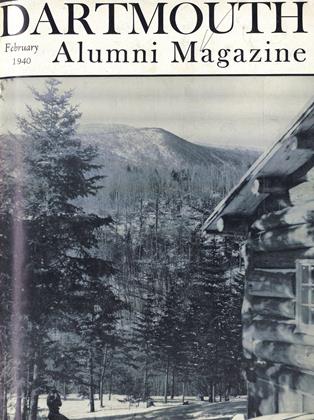THE SCOPE AND VARIETY of extra-curricular activities as they have developed in recent years, and as described by Professor Allan Macdonald in his article "Education Without Books" in this issue, may surprise readers. Not so long ago when one spoke of pursuits on the campus outside of classroom work, one had exclusively in mind athletics, heeling for a student publication, dramatics, glee club or band, or some other of the traditional student activities.
With the tremendous growth of interest in the Outing Club and so-called "after-college sports" (skiing, squash, golf, tennis), the base was formed for the field of enlarged activities. Very probably the trend, as it appears to be, is common in many colleges and universities. There are even, one notes, outing clubs and ski clubs formed at Harvard, Yale, Princeton, Cornell, Smith, and other institutions.
Impressive evidence of the importance attached to certain distinctive student activities is the grant to Princeton by the Carnegie Foundation of $75,000, spread over a five-year period, for an "experimental program in creative arts." The announcement of this generous donation by a Foundation that enjoys the greatest respect for its educational views expressed the interest of the Carnegie Trustees in plans at Princeton to develop student interest in literature, music, and the plastic arts. Presumably this program is carried on without academic Credit. Dartmouth has provided places in the Hanover community for its Paul Sample (artist), Richard Weaver (naturalist), Ray Nash (graphic arts), Wedgewood Bowen and Robert Denison (museum club), and Ross McKenney (woodsman and guide). From Harvard comes interesting news of a radio workshop created by undergraduate interest, functioning with the advice and help of members of the faculty, and without recognition as an academic part of the university.
So far these newer extra-curricular activities are minority interests. Mr. Macdonald modestly does not attempt to present an essay on educational theory and policy; he resists the temptation to describe the possible trend in education in terms of too eloquent enthusiasm. Here are matters of fact—small groups of undergraduates are with keen interest turning to the guidance of professionals who are themselves first-rate teachers in certain branches of the creative and manual arts. These men are experts who come to the campus in sponse to student and faculty desire for guidance in activities that will broaden and stimulate men's minds in youth, and may be carried on in later life.
The movement, in principle and in detail, is neither vocational nor is it designed to give men a pleasant hobby. The approach, fortunately, is just as exacting in respect to time and effort of the participant as in the courses listed in the College Bulletin. If a constructive suggestion is in order as a result of Mr. Macdonald's study of the intriguing trend, and his stimulating story of it, it would be interesting to see what the opinion of a group of students and officers of the College might be from a survey of all extra-curricular activities, including a study of what should be their relation to the purposes of the College.
 View Full Issue
View Full Issue
More From This Issue
-
 Article
ArticleMore Than Professor
February 1940 By JOHN HURD JR. '21 -
 Article
ArticleThe College In The Sixties
February 1940 -
 Class Notes
Class Notes1915*
February 1940 By CHARLES R. TAPLIN -
 Article
ArticleEducation Without Books
February 1940 By Davis Jackson '36 -
 Sports
SportsBig Green Teams
February 1940 By Whitey Fuller '37 -
 Article
ArticleHanover Browsing
February 1940 By HERBERT F. WEST '22
The Editor
-
 Article
ArticleGradus Ad Parnassum
October 1936 By The Editor -
 Article
ArticleGradus Ad Parnassum
March 1931 By The Editor -
 Article
ArticleGradus Ad Parnassum
October 1937 By The Editor -
 Article
ArticleGRADUS AD PARNASSUM
July 1940 By The Editor -
 Article
ArticleCensor Alumni News
March 1942 By The Editor -
 Article
ArticleBad News for Our Readers
October 1943 By The Editor








